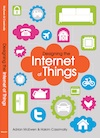
Who are you, and what do you do?
I'm Hakim, and though I’d pretty much planned to be a famous musician or novelist by now, I appear to be a software developer. Currently I’m working with mySociety on making web applications that empower citizens, sometimes in unexpected ways, like helping them engage with their local council for the first time to report a pothole.
Last year I became a “proper author” with Designing the Internet of Things published by Wiley. We’ve recently been told we should be getting translated into Italian soon by Apogeo, which is very exciting indeed.
I work remotely, so to keep myself from going insane from never seeing anybody, I have a desk at Liverpool’s premier co-working, community, and makerspace DoES Liverpool which I helped co-found over two years ago.
What books influenced you the most?
Though I was blown away by Swallows and Amazons, I’ve only twice set foot on a sailing dinghy. And though I read and re-read Gerald Durrell’s The Donkey Rustlers, I’ve not actually (yet) masterminded any acts of asinine terrorism. It’s hard to tell exactly how reading as a child influenced me, but I know I would be a different person if I hadn’t always had my nose in a book while growing up.
To pick just one children’s book to represent this, because it’s one I’ve read again as an adult and still love, Ursula Le Guin’s Earthsea Trilogy (as it still was) is really close to my heart. It’s about learning and words, and the power of names: things that are vitally important to any writer or programmer.
You can’t understand an atrocity like the Holocaust from facts and figures. Reading If This Is A Man never feels like a worthy chore, and is certainly never merely “depressing” but truly tragic, telling not just of the horror of the machinery of inhumanity, but also of the humanity that persists. Of course I identified with Primo Levi himself, a shy, bookish man, who survived at least in in part precisely because of his intelligence and study. But most impressive is his objectivity and calm, and his refusal to rush to simple or convenient criticism of any person or group or race. When he does focus his anger, however, the results are precise and devastating. When I first travelled to Italy, I’d never heard of Lake Garda or Florence’s Ponte Vecchio but dragged my friend Rob to Turin to seek Levi’s grave (we never found it) and bought a copy of the original book, Se questo è un uomo, from a tiny bookshop using our Rough Guide’s basic phrasebook and French. The next year I switched from a pure English Literature degree course to a joint honours with Italian to learn how to read it.
At my first job, working on one of Unilever’s multilingual IT helpdesks, I mentioned to one of my more technical colleagues James that I had used to enjoy programming before studying literature. He lent me a copy of Learning Perl. The book was funny but not not over-cutesy, well paced and clearly explained. And Perl itself was a revelation: concepts like “truthiness”, the implicit topic variables, and context showed me a language that was compact and powerful, pragmatic yes but oddly elegant too. As an introductory guide, I’m unlikely to ever re-read it, but given that 15 years later I am still working as a programmer, largely with Perl, it’s safe to say it was an influential book.
What book you would like to write?
Writing is, in some ways, harder than coming up with the idea for one, so I have far too many ideas for books to list. The last technical book I enthusiastically started is a guide to purely functional data structures in impure languages, the abandoned skeleton of which is still languishing on github.




